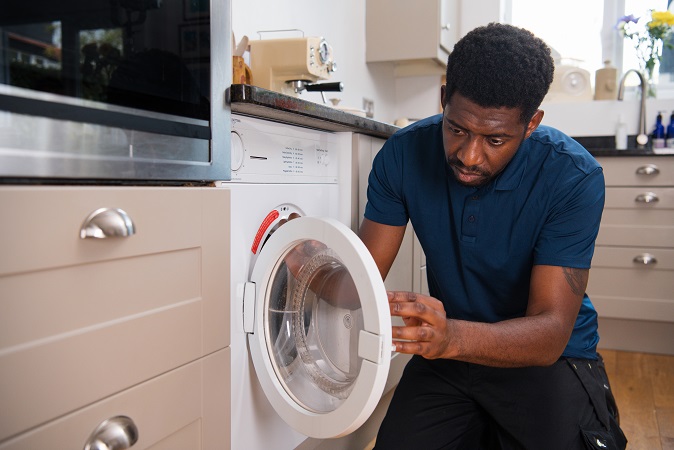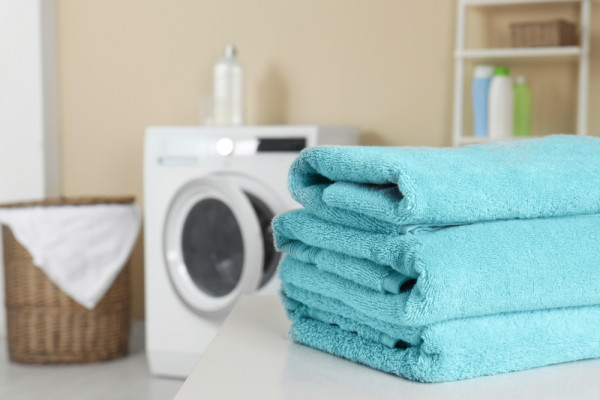Are you in the market for a new tumble dryer? Perhaps you just want to know what a condenser tumble dryer is? Or maybe how it differs to a vented tumble dryer? If so, you’re in the right place because we’re about to look closer at them – and what sets them apart.
What is a condenser tumble dryer?
A condenser dryer works by drawing moisture from your laundry and containing it in a condenser unit. This unit cools the hot, moist air, condensing it into water droplets. These droplets are then collected in a water tank that you can empty after each drying cycle.
One of the main advantages of condenser tumble dryers is their self-contained design. Because they don’t need a vent to expel moist air, you can put them anywhere in your home (provided you have the space and access to a power outlet!) So they’re perfect for apartments or homes where external venting isn’t an option.
They usually come with advanced settings too. So you have more control over drying cycles and can get better results for different types of laundry – delicate fabrics like silk or wool, for instance.
How to use a condenser tumble dryer

To make sure you’re using a condenser dryer properly, start by emptying the water tank after each cycle to stop any overflow. It's also important to remove and clean the condenser unit regularly to keep it performing at its best. Depending on how much you use your dryer, you should aim to clean the condenser every one to three months.
Although it doesn’t need external ventilation, you should still make sure your dryer is placed in a well-ventilated area. This helps avoid any buildup of heat in the room, which would be uncomfortable for anyone living with it – not to mention a potential fire hazard. It also means there’s less chance of mould or mildew growth.
Finally, check and clean the lint filter after each cycle to prevent any blockages and maintain a good airflow. We’ve got some helpful information on how to clean a tumble dryer filter.
What is a condenser tumble dryer best suited for?
Condenser tumble dryers are perfect for situations where you might not have an outside vent like in an apartment or basement. Their self-contained design means you can really put them anywhere – against internal walls or in small spaces. Also, condenser dryers can usually cope with a greater variety of fabrics.
What is a vented tumble dryer

Now let’s look at vented tumble dryers. In contrast to condenser dryers, which collect moisture in a tank, vented dryers expel damp air through a vent – usually leading outside through a wall or window. By removing moisture directly, they have faster drying times which means they use less energy. But as vented dryers need to be near an outside wall, you have less freedom about where to place them.
How to use a vented tumble dryer

A vented tumble dryer needs regular maintenance to perform at its best. While it doesn't have a water tank to empty or a condenser to clean, you should still clean the lint filter after every use. By clearing any buildup, the air can flow easily which is just what your machine needs.
Remember to also check the vent hose isn’t blocked and that it’s correctly connected. By doing this from time to time, you’ll always be sure the moisture is being removed properly.
What is a vented tumble dryer best suited for?
If you have access for external venting and prefer a simpler machine with less maintenance, vented tumble dryers are the better choice. They’re more straightforward to use as you don’t need to worry about ever emptying a water tank or cleaning a condenser unit. Vented dryers are also often more energy-efficient, as they expel damp air outdoors which means faster drying times.
Which is best: condenser or vented tumble dryer?
When comparing condenser and vented tumble dryers, you should consider a few things:
- Difference in drying time: By expelling moisture externally, vented tumble dryers win with shorter drying times than condenser dryers.
- Ease of installation: Condenser dryers offer more flexibility in placement, as they don't need external venting like vented dryers do.
- Appliance cost: Condenser dryers typically cost more than vented models due to their advanced technology and flexibility.
- Energy efficiency and lifetime cost: Vented dryers tend to be more energy-efficient, resulting in lower operating costs over their lifetime compared to condenser dryers.
- Lifespan: Both types of dryers have similar lifespans, so how well they last can depend on how well they’re maintained.
- Upkeep: Condenser dryers need regular cleaning of the condenser unit and water tank, while Vented dryers need regular maintenance of the vent hose and lint filter.
- Differences in capacity: You can buy both types of dryer in sizes to suit your household needs.
- Reliability: Vented dryers are often seen as being reliable due to their simpler design and fewer components.
Considering factors like reliability and lifespan can help you make a more informed decision when it comes to choosing between condenser and vented tumble dryers. We’ve got some helpful advice if you want to know more about the cost of running a tumble dryer.
Contact us if you need a tumble dryer repair
So, the choice between a condenser and vented tumble dryer really comes down to things like drying time, where to place it, energy efficiency, and maintenance preferences. While both models have their pros and cons, reliability and lifespan are key if you’re looking for long-term satisfaction.
If you're having any problems with your tumble dryer, don't let it dampen your day. Whatever your dryer, you can get your machine up and running again with an expert repair.
Our blog is loaded with more related articles

Tumble dryer tips
Cost of running a tumble dryer
In the rainy UK, we can’t hang laundry outside for much of the year. So perhaps you’re looking at tumble dryers and...
Read more

Tumble dryer tips
How to clean a condenser tumble dryer
It’s important to clean your dryer regularly to ensure it works properly. Find out how to clean a condenser tumble dryer...
Read more

Tumble dryer tips
Tumble dryer buying guide: what to look for in a new dryer
Looking for a new tumble dryer but feeling overwhelmed by the options? Our buying guide covers everything from capacity to ener...
Read more
